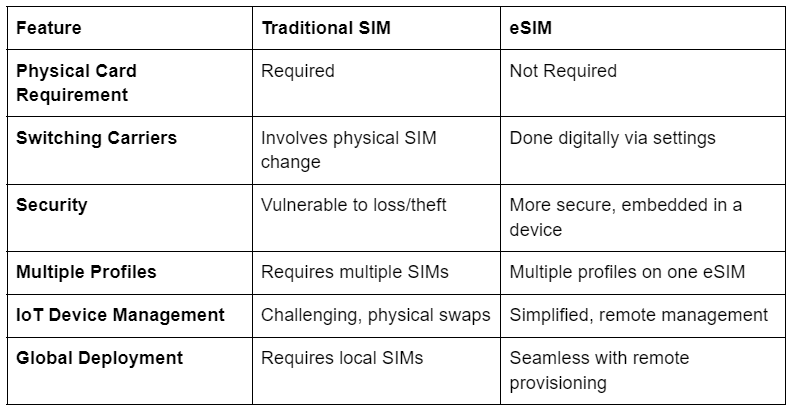The Future of Mobile Connectivity with eSIM Technology
With the advancement of mobile technology in recent years, eSIM (embedded SIM) is emerging as an essential development of the mobile connectivity market. Due to rising demands for flexibility, security, and operational efficiency in mobile communications, eSIM technology is shaping new approaches to connecting devices to networks, particularly in 5G and IoT.
eSIM: The Game Changer in Mobile Connectivity
The eSIM technology is not simply an additional innovation added to the communication of mobility. It is a new approach to the connectivity of devices where the user enjoys flexibility that has rarely been seen before. This flexibility is particularly crucial for frequent travelers, digital nomads, and businesses managing multiple devices across different regions.
eSIM enhances connectivity by allowing users to seamlessly switch to a local network without needing to purchase a new SIM card, significantly improving convenience and reducing costs. For instance, while traveling in the UK, you may encounter high roaming charges and limited access to local networks, complicating your connectivity.
Fortunately, eSIM technology resolves these issues by enabling users to activate a local network effortlessly. Using a UK eSIM for travel allows you to bypass these challenges and stay connected with ease. This innovation not only streamlines your travel experience but also helps you avoid unexpected costs associated with traditional SIM cards.
Enhanced Security and Simplified Management
Security is one more field that benefits greatly from the implementation of eSIM technology. Standard SIM cards can be subject to loss or theft and therefore can be cloned, which poses security risks. eSIMs, however, are physically integrated within the gadget’s frame, which makes them more secure. They can be centrally controlled, which is an added bonus for enterprises, and they may be required to secure their devices across several sites.
eSIM capability facilitates the storage of multiple profiles on one device, which is smart and beneficial for businesses. It also makes management easier because when the IT departments are required to change the carrier profile or the data plan, they do not require physical access to the mobile devices. This remote management capability improves security while at the same time increasing operation effectiveness.
Driving the IoT Revolution
One of the hottest trends in the tech industry currently is the Internet of Things (IoT) and eSIM is seen as an enabler in the process. Smartwatches and other similar gadgets, as well as industrial and commercial sensors, need to stay connected most of the time. These devices, if were to be configured with normal SIM cards, would be a nightmare to manage especially for large-scale deployments.
All these challenges can be overcome with eSIM technology, as it allows connectivity to be provisioned and managed remotely. Devices can be installed anywhere in the world without the need to remove SIM cards, making eSIM particularly well-suited to the IoT market. This capability is already driving innovations such as smart cities, connected automobiles, and industrial applications that require reliable and scalable connectivity.
Comparison Table: Traditional SIM vs. eSIM

Impact on Telecom Industry
It is also contributing to a significant change in the telecommunications business through eSIM technology. Originally, the role of providing and distributing SIM cards was in the hands of mobile carriers effectively locking their clients into their networks. Thus, through the granting of power to the consumers to switch between the carriers of their desired choice anytime, eSIMs disrupt this model. When this change happens, the competition between carriers will be stiff hence motivating the carriers to offer better deals and services for their customers.
The key transition that telecom companies need to make is shifting the center of value proposition from contract-locking models to customer experience delivery models. It also uncovers possibilities for new types of business especially an unconventional and innovative strategy for example the roll-over, on-demand kind of plans allowing subscribers to turn on and off their deals when they wish to. This flexibility may be viewed as constructive, particularly with the current trend of personalization with the user at the center of attention.
Preparing for the 5G Era
The role of eSIM in people’s lives is growing, and with the emergence of new generations like 5G, eSIM will only become even more significant. With better throughput, lower delay, and higher density of network connections, the 5G network will pave the way for a new wave of IoT devices and services. However, the connectivity of these devices with the traditional SIM cards would be a cumbersome task and not very efficient.
eSIMs, therefore, provide operators with effective solutions to improve the handling of 5G devices. They enable users to roam across different 5G networks, allowing them to choose the most efficient network in their area. This makes eSIMs particularly relevant for frequent travelers and companies, whose performance often depends on high-speed Internet connectivity.
In addition, the evolution of connected objects through the deployment of 5G has the potential to provide a vast number of IoT devices with relatively secure connections, making it crucial to develop a solution that ensures the connectivity remains scalable as the number of connected objects increases. This is where eSIM technology comes in handy since it facilitates remote management of 5G devices irrespective of their location, to ensure they continue to connect and fully function as intended.
Challenges and Considerations
It is important to understand that eSIM technology has its pros and cons, and this article will outline them all. Central to the issue is the question of how eSIMs can be integrated with currently available hardware. While many newly released smartphones, tablets, and wearable devices offer support for eSIM technology, older-generation devices do not. This limitation means that widespread adoption will likely be gradual, as consumers will need to continuously update their gadgets.
Another critical factor is the necessity for carriers to support eSIM technology. Although many carriers are beginning to roll out eSIM services, not all do so. This presents a contradiction in eSIM technology, which prides itself on offering flexibility, especially for travelers or residents in areas with limited network options.
However, eSIM technology has something that might be regarded as an element of risk and it is a learning curve. Many consumers are familiar with old-school SIM cards and it might be daunting for them to set up, and even more so, control an eSIM. In order to ensure higher uptake of eSIM technology, consumers will need to be educated and the necessary tools and interfaces will have to be made more user-friendly.
Embracing the Future of Connectivity
The future of mobile connectivity lies in eSIM technology. As more devices and networks adopt eSIM, we can expect a more seamless, secure, and flexible mobile experience. This technology is not just a step forward; it's a leap towards a more connected world, where switching carriers, managing multiple devices, and securing connectivity is as simple as a few taps on a screen.
As we move into the 5G era and beyond, the role of eSIM will only grow more significant. It’s time for consumers, businesses, and telecom companies to embrace this technology and unlock the full potential of mobile connectivity.
Are you ready to experience the future of mobile connectivity? Consider upgrading to an eSIM-enabled device and explore the possibilities that come with this innovative technology. Stay ahead of the curve and ensure you're prepared for the next generation of mobile networks.
Frequently Asked Questions
1. Will eSIM technology work with all mobile carriers?
While eSIM technology is gaining widespread support, not all carriers currently offer eSIM services. Before adopting eSIM, it's essential to check whether your preferred carrier supports it. As the technology becomes more popular, it's expected that more carriers will adopt eSIM services, expanding the options available to consumers.
2. Can I use multiple carriers on a single device with eSIM?
Yes, one of the significant advantages of eSIM technology is the ability to store multiple profiles on a single device. This means you can switch between carriers or data plans without needing to swap physical SIM cards. This feature is particularly useful for frequent travelers or those who need to manage multiple phone numbers.
3. How secure is eSIM compared to traditional SIM cards?
eSIMs offer enhanced security compared to traditional SIM cards. Since they are embedded directly into the device, they cannot be physically removed, lost, or stolen. Additionally, eSIMs can be remotely managed and updated, reducing the risk of SIM card cloning or other security breaches.











